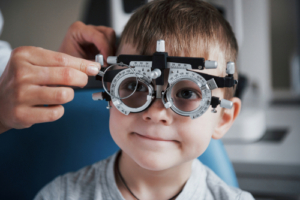When Does My Child Need Their First Eye Exam?
Even if your child seems like they can see well, eye exams are still necessary. As children get older, their eyes are also developing and growing.
But when does your child need their first eye exam? Eye doctors agree that for the best vision health, infants should start by receiving a vision screening.
Regular eye exams ensure that children can see and perform to the best of their ability in school. Keep reading to learn more about the importance of regular eye exams for children!
Newborns
Newborns can see, but their vision is not fully developed. They have blurry vision when they are first born, but their ability to see improves as they grow older.
Issues at this age can limit optical development, potentially slowing their learning. It’s common for babies up to age two months to look around without focusing.
You may notice that your baby’s eyes cross occasionally, but this is normal as well.
Newborns at this age have limited abilities to focus or move from one image to another. They can see best about 10 inches away, an essential factor that helps them see their parent’s faces.
Have your pediatrician or another trained health professional examine your newborn’s eyes. Newborns should have a vision screening that tests for a “red reflex” to see if they can see red eyes in a photograph.
They do this by shining a bright light in each eye. If the light doesn’t return a red reflex, it may require further testing. Other testing done during your infant’s first vision screening includes testing their blink and pupil responses.
Your newborn should see an ophthalmologist for a comprehensive eye exam if born prematurely, they show any signs of eye disease, or there’s a family history of childhood eye diseases.
Infants Six to Twelve Months Old

Babies aged six months to one year go through significant visual growth. They develop eye-body coordination and gain depth perception.
They learn how to see the world as three-dimensional and see color. As infants learn to crawl, their visual skills improve. Babies who crawl a lot gain eye, hand, foot, and body coordination that helps them use both eyes together.
Infants six months to a year old should have a second vision screening during their first year of life. The screening is usually performed during their well-child exam that takes place between six and 12 months.
Your pediatrician can perform these tests that will allow them to check that your infant’s eyes move correctly and align as they should. They should also visually inspect their eyes to ensure they are developing appropriately with their age.
Babies Twelve to Thirty-Six Months
When your child is between twelve and thirty-six months, they need to be checked for healthy eye development. A vital component of this is a photo screening test.
During this test, your child’s pediatrician will use a special camera to take pictures of your child’s eyes. They’ll use these pictures to determine if your child has amblyopia, also known as lazy eye. Amblyopia is a condition that’s the most common eye problem that can develop among young children.
It happens as the brain communicates with one eye more than the other. As a result, the eyes will look in different directions.
Not treating amblyopia can cause developmental imbalances. Children who have amblyopia may have significantly reduced depth perception and vision.
Treating this condition before the age of five is critical in restoring regular visual capabilities and getting your child back where they should be for their development.
If there are any visible problems, you may get referred to an ophthalmologist.
Preschool Age Children, Three to Five Years Old

As your child reaches the age of preschool, they are beginning to draw and copy shapes. Their vision should be close to 20/20 and nearly at the level it will stay into adulthood.
Children should start to recognize letters and shapes and may begin reading. Their depth perception will fully develop within about two years.
Make sure you take your toddler to see an eye doctor before they start preschool at around the ages of three to five. Your child’s doctor will use eye charts to ask your toddler about identifying pictures and letters. They will also examine their visual acuity to ensure your child can see object outlines and colors.
Your child should see an ophthalmologist if they display any signs of refractive errors, amblyopia, eyes out of alignment, or other issues with focusing. Prompt treatment is the best way to protect your child’s vision.
Children Five and Up

Once your child has turned five, they need to be screened for alignment and visual acuity. This can be performed by a healthcare professional, optometrist, or ophthalmologist.
You may not realize your child has any issues with their vision unless they start struggling in school. It’s quite common to learn that your child may be nearsighted or farsighted if they squint when they need to see the whiteboard in class or to look at a presentation on a screen.
You may notice them move closer to things they want to see better, like the television at home. You may also notice your child starts to cover one eye as a way to try and see more clearly.
This adjustment may be a sign of having amblyopia. Regular headaches and eye pain can be signs a child needs to wear glasses.
Wearing prescription glasses can treat nearsightedness, farsightedness, and astigmatism in children. If your child doesn’t seem interested in wearing their glasses, start by letting them pick out their frames.
Make sure to reassure them that they look great in their glasses, and more importantly, remind them that they are a fantastic tool to help them see better.
If your child plays sports or is very active, you may want to think about buying them sports glasses. With sports glasses, your child won’t have to worry about breaking their everyday glasses, and they will be able to keep their eyes protected. These sets have elastic bands in place of plastic temples to keep them on.
If your child wears glasses or contact lenses, they need to see their eye doctor every year. Their eyes are still developing, and they may need to update their prescription more often.
Consider setting up a regular eye exam appointment for a few weeks before school starts. This timing ensures your child’s eyes will be in the best possible shape before they have to go back to school.
Teenagers

Even if your teenager doesn’t need to wear glasses or contact lenses, they should still have an eye exam every year. Your teenager’s eye doctor will use their appointment to measure their eye muscle coordination, as well as testing their peripheral vision. They may examine the pupils to look for light responses and check for high eye pressure.
Although many people assume that problems with vision can only develop when your child is young, your teenager can still become nearsighted or farsighted at a later age. If this is the case, your teen can wear glasses or contacts to correct their vision.
If your teen spends a lot of time looking at digital devices like their phone, tablet, or computer, they may develop digital eye strain. Spending too much time looking at devices without a break can lead to eye fatigue.
The blue light emitted from phones and computers can dry out the eyes and make them feel tired. It may also disrupt the circadian rhythm and make it harder for your teen to fall asleep and stay asleep.
Looking at a phone before bed, for example, may trick their brains into thinking it’s still light out. Avoiding screens for half an hour before bed can limit this effect.
If your teen experiences eye trauma of any kind, take them to see their eye doctor immediately. Eye trauma can occur due to sports injuries or a car accident and may require prompt treatment to prevent permanent vision loss.
Does your child need an eye exam this fall? Schedule one at Eye Consultants of North Dakota in Fargo, ND, today!



